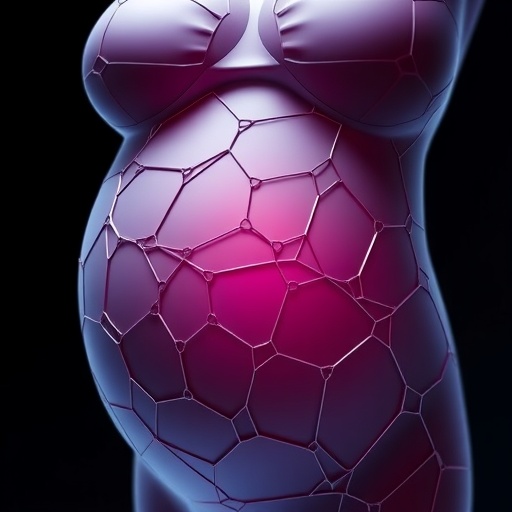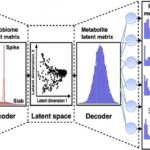
In a groundbreaking study published in Nature Communications, researchers Montanaro, Kacar, Iannaccone, and their colleagues have illuminated new horizons in the management of connective tissue disorders during high-risk pregnancies. This pioneering work focuses on the application of Personalised External Aortic Root Support (PEARS), a novel surgical intervention designed to mitigate life-threatening cardiovascular complications commonly associated with connective tissue abnormalities.
Connective tissue disorders, such as Marfan syndrome and Loeys-Dietz syndrome, affect the structural integrity of the aortic wall, predisposing patients—especially pregnant women—to aortic root dilation and catastrophic aortic dissection. The physiological stresses induced by pregnancy exacerbate these vulnerabilities, placing both mother and fetus at significant risk. Addressing these intricate challenges demands cutting-edge strategies that combine personalized medicine with advanced cardiovascular surgery.
The PEARS technique represents a transformative approach. Unlike traditional aortic replacement surgeries that replace the diseased segment with synthetic grafts, PEARS employs a bespoke, externally-fitted mesh sleeve crafted using patient-specific imaging data. This customized sleeve provides mechanical reinforcement to the aortic root, thereby preventing further dilation while preserving native valve function and vascular compliance—a feat rarely achieved by conventional surgical methods.
.adsslot_I8X4MTwUNb{width:728px !important;height:90px !important;}
@media(max-width:1199px){ .adsslot_I8X4MTwUNb{width:468px !important;height:60px !important;}
}
@media(max-width:767px){ .adsslot_I8X4MTwUNb{width:320px !important;height:50px !important;}
}
ADVERTISEMENT
This study meticulously chronicles a series of pregnant patients with documented connective tissue disorders who underwent PEARS implantation. Pre-operative planning leveraged high-resolution magnetic resonance imaging (MRI) and computed tomography (CT) angiography to construct three-dimensional models of the aortic root. These models were integral for designing and manufacturing polymer meshes tailored to each patient’s unique vascular anatomy, highlighting the synergy between advanced imaging, biomechanical engineering, and clinical application.
Throughout the case series, the researchers underscore the imperative of timing in surgical intervention. The window during pregnancy when PEARS implantation is safest and most effective demands careful orchestration. The report details strategies for perioperative management, emphasizing hemodynamic stability and minimization of fetal exposure to anesthesia. The outcomes demonstrate that PEARS not only forestalls catastrophic aortic events but also fosters favorable pregnancy progression.
Crucially, the study dives into intricate hemodynamic analyses post-PEARS incorporation. Computational fluid dynamics simulations revealed that the external support optimized shear stress distribution along the aortic wall, reducing pathological remodeling stimuli. These biomechanical insights elucidate the mechanistic basis for PEARS’s efficacy in reinforcing the aortic root without impairing native arterial elasticity, thereby maintaining physiological blood flow dynamics essential for maternal and fetal health.
The clinical implications extend beyond immediate surgical outcomes. The article explores the longitudinal follow-up of patients, revealing sustained durability of PEARS and negligible incidence of aortic complications during late gestation and postpartum periods. This observation significantly challenges existing paradigms, which predominantly rely on prophylactic aortic root replacement pre-conception or undesirable pregnancy interruptions.
Moreover, the researchers address potential complications and limitations inherent in PEARS. While the polymer mesh material exhibited excellent biocompatibility and mechanical resilience, the study acknowledges the necessity for vigilant surveillance post-implantation. Factors such as mesh migration, inflammatory reactions, and interaction with adjacent cardiac structures require ongoing scrutiny to optimize long-term safety and efficacy.
A remarkable aspect of this study is the multidisciplinary collaboration integrating cardiologists, geneticists, cardiovascular surgeons, obstetricians, and biomedical engineers. This convergence was critical to navigate the complex interface between genetic connective tissue pathology and the hemodynamic demands of pregnancy, culminating in a patient-centered solution that bridges gaps between molecular diagnosis and surgical innovation.
In addition to its profound clinical relevance, the research sets a precedent for personalized surgical interventions utilizing additive manufacturing and patient-specific anatomical modeling. The PEARS procedure epitomizes the potential of precision medicine to tailor therapeutic devices that conform intricately to individual morphologies, paving pathways for similar innovations across cardiovascular and other surgical domains.
The psychological and social dimensions of this work are not overlooked. Expectant mothers with connective tissue disorders often grapple with anxiety related to potential aortic events and pregnancy risks. By offering a safer alternative with demonstrable success, PEARS holds promise for alleviating these burdens and improving quality of life, alongside advancing maternal-fetal medicine.
Looking ahead, the team proposes expansive clinical trials to validate PEARS in larger, more diverse cohorts and to refine material properties for enhanced performance. They emphasize the integration of genetic profiling to better stratify risk and personalize intervention timing. Such future research could unveil mechanisms underlying connective tissue fragility and inform preventive strategies beyond surgical reinforcement.
Furthermore, this innovative procedure challenges current guidelines on managing connective tissue disorders in pregnancy. It advocates for a paradigm shift favoring earlier intervention with personalized, less invasive support devices over conventional, more radical surgeries or pregnancy termination options. The study thus has broad implications for clinical policy and patient counseling worldwide.
The integration of PEARS into multidisciplinary care pathways exemplifies a holistic approach to a complex clinical challenge. By harmonizing molecular genetics, cardiovascular physiology, surgical craftsmanship, and robust imaging, this technique offers hope for safer pregnancies and reduced maternal morbidity in an otherwise vulnerable population.
Montanaro and colleagues’ work marks a watershed moment in cardiovascular surgery and maternal health. It underscores the transformative potential of merging emerging technologies—high-resolution imaging, 3D printing, computational modeling—with compassionate clinical care to tackle formidable medical obstacles.
In conclusion, the case series presented by Montanaro et al. signals a revolutionary leap forward in individualized treatment for pregnant patients with connective tissue disorders. Through the sophisticated application of PEARS, this research illuminates a viable path to safeguarding lives by fortifying the fragile aortic root, enabling high-risk pregnancies to progress with unprecedented safety and hope.
Subject of Research: Connective tissue disorders and high-risk pregnancy management using personalized external aortic root support.
Article Title: Connective tissue disorder and high risk pregnancy: a case series with personalised external aortic root support (PEARS).
Article References:
Montanaro, C., Kacar, P., Iannaccone, G. et al. Connective tissue disorder and high risk pregnancy: a case series with personalised external aortic root support (PEARS). Nat Commun 16, 6165 (2025). https://doi.org/10.1038/s41467-025-61241-y
Image Credits: AI Generated
Tags: advanced cardiovascular techniquesaortic root dilation riskscardiovascular complications in pregnancyconnective tissue disorders in pregnancyhigh-risk pregnancies and surgeryinnovative treatments for connective tissue abnormalitiesLoeys-Dietz syndrome treatmentMarfan syndrome managementmaternal-fetal health in connective tissue disorderspatient-specific surgical approachesPEARS surgical interventionpersonalized medicine in surgery



